Understanding the 60s
VerifiedAdded on 2023/04/07
|7
|1671
|163
AI Summary
The 1960s in the post Civil War America was a turbulent time when the civil rights movement was very much a characteristic feature of the political scenario that prevailed during that period of time. This essay discusses the contributions of Martin Luther King and analyzes the current situation to show how far have the situations changed in the present times in the country.
Contribute Materials
Your contribution can guide someone’s learning journey. Share your
documents today.
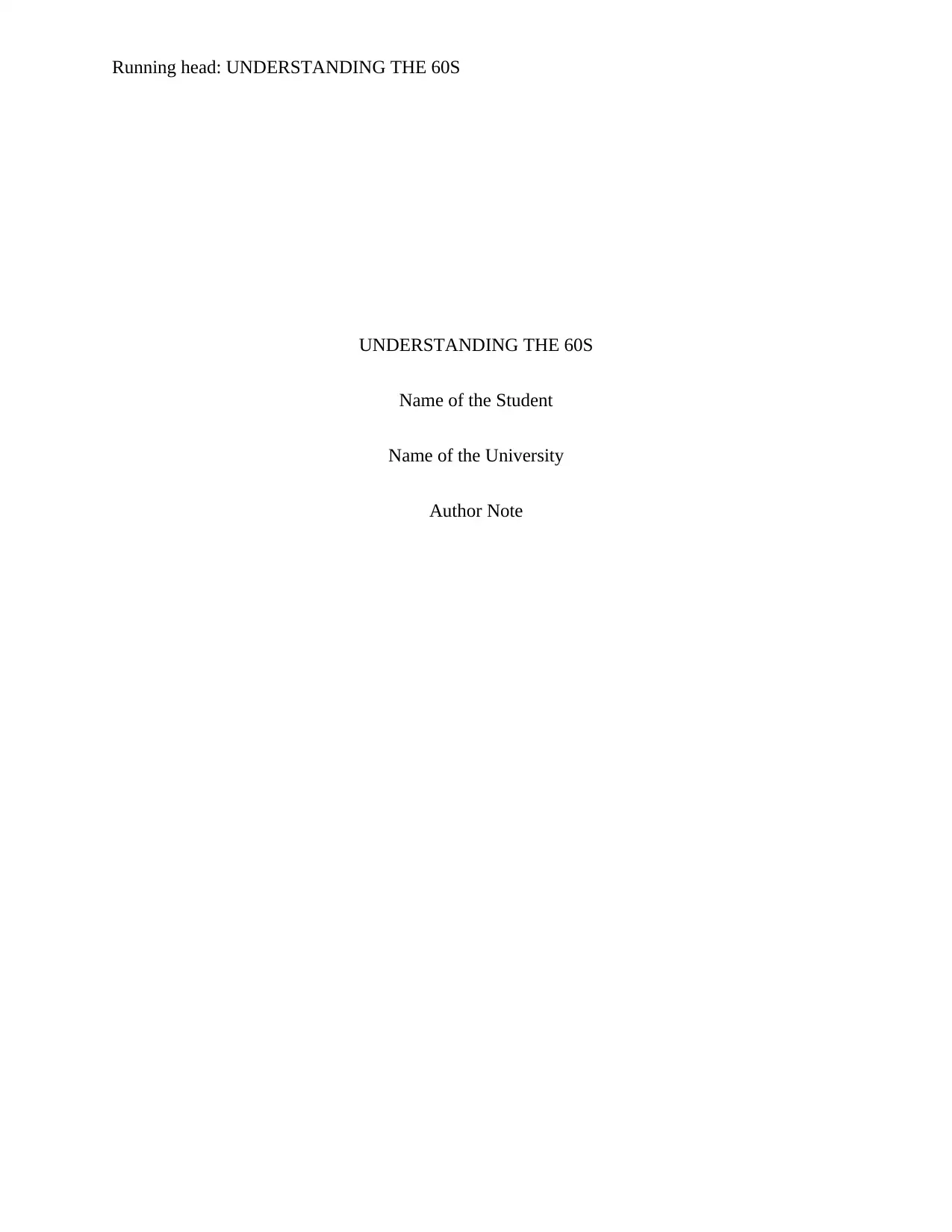
Running head: UNDERSTANDING THE 60S
UNDERSTANDING THE 60S
Name of the Student
Name of the University
Author Note
UNDERSTANDING THE 60S
Name of the Student
Name of the University
Author Note
Secure Best Marks with AI Grader
Need help grading? Try our AI Grader for instant feedback on your assignments.
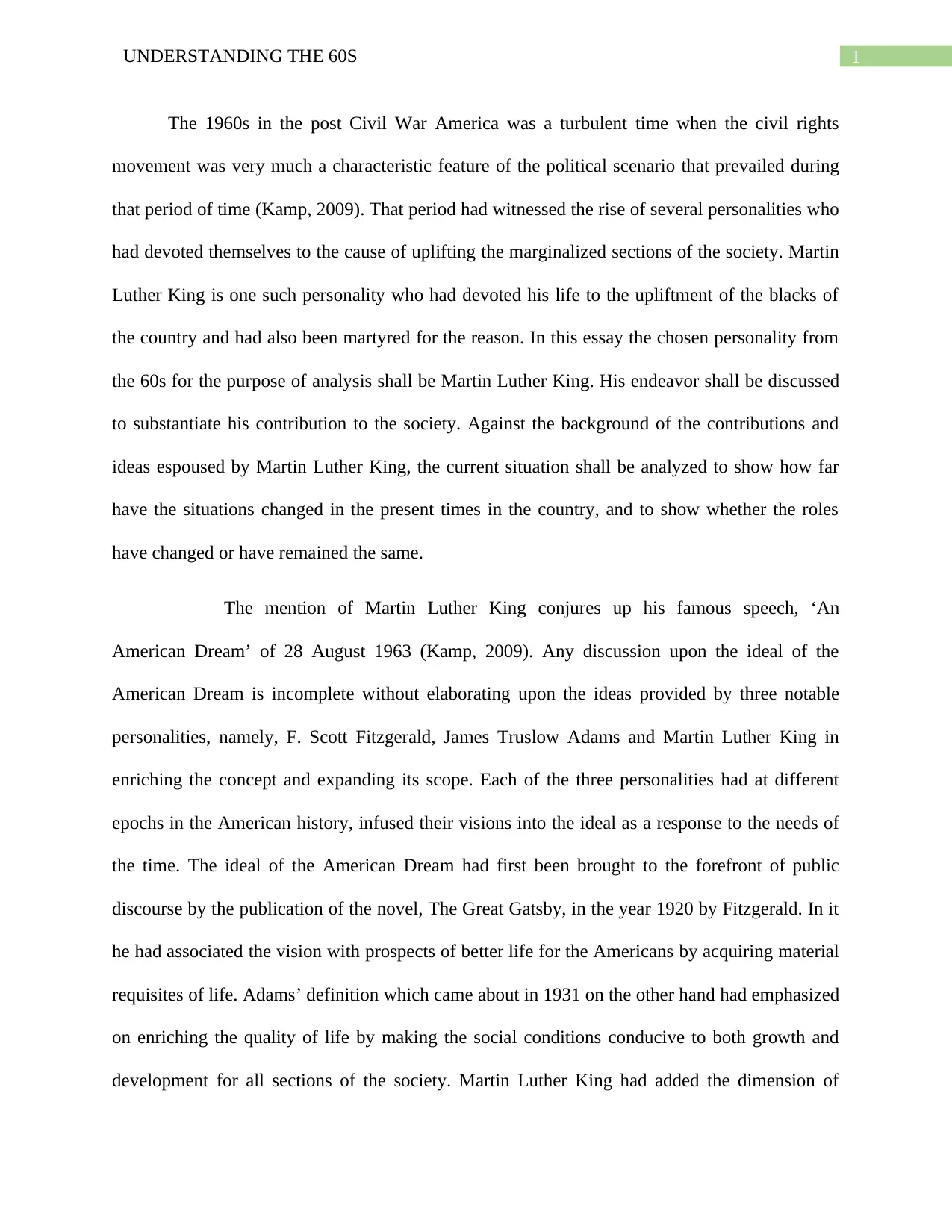
1UNDERSTANDING THE 60S
The 1960s in the post Civil War America was a turbulent time when the civil rights
movement was very much a characteristic feature of the political scenario that prevailed during
that period of time (Kamp, 2009). That period had witnessed the rise of several personalities who
had devoted themselves to the cause of uplifting the marginalized sections of the society. Martin
Luther King is one such personality who had devoted his life to the upliftment of the blacks of
the country and had also been martyred for the reason. In this essay the chosen personality from
the 60s for the purpose of analysis shall be Martin Luther King. His endeavor shall be discussed
to substantiate his contribution to the society. Against the background of the contributions and
ideas espoused by Martin Luther King, the current situation shall be analyzed to show how far
have the situations changed in the present times in the country, and to show whether the roles
have changed or have remained the same.
The mention of Martin Luther King conjures up his famous speech, ‘An
American Dream’ of 28 August 1963 (Kamp, 2009). Any discussion upon the ideal of the
American Dream is incomplete without elaborating upon the ideas provided by three notable
personalities, namely, F. Scott Fitzgerald, James Truslow Adams and Martin Luther King in
enriching the concept and expanding its scope. Each of the three personalities had at different
epochs in the American history, infused their visions into the ideal as a response to the needs of
the time. The ideal of the American Dream had first been brought to the forefront of public
discourse by the publication of the novel, The Great Gatsby, in the year 1920 by Fitzgerald. In it
he had associated the vision with prospects of better life for the Americans by acquiring material
requisites of life. Adams’ definition which came about in 1931 on the other hand had emphasized
on enriching the quality of life by making the social conditions conducive to both growth and
development for all sections of the society. Martin Luther King had added the dimension of
The 1960s in the post Civil War America was a turbulent time when the civil rights
movement was very much a characteristic feature of the political scenario that prevailed during
that period of time (Kamp, 2009). That period had witnessed the rise of several personalities who
had devoted themselves to the cause of uplifting the marginalized sections of the society. Martin
Luther King is one such personality who had devoted his life to the upliftment of the blacks of
the country and had also been martyred for the reason. In this essay the chosen personality from
the 60s for the purpose of analysis shall be Martin Luther King. His endeavor shall be discussed
to substantiate his contribution to the society. Against the background of the contributions and
ideas espoused by Martin Luther King, the current situation shall be analyzed to show how far
have the situations changed in the present times in the country, and to show whether the roles
have changed or have remained the same.
The mention of Martin Luther King conjures up his famous speech, ‘An
American Dream’ of 28 August 1963 (Kamp, 2009). Any discussion upon the ideal of the
American Dream is incomplete without elaborating upon the ideas provided by three notable
personalities, namely, F. Scott Fitzgerald, James Truslow Adams and Martin Luther King in
enriching the concept and expanding its scope. Each of the three personalities had at different
epochs in the American history, infused their visions into the ideal as a response to the needs of
the time. The ideal of the American Dream had first been brought to the forefront of public
discourse by the publication of the novel, The Great Gatsby, in the year 1920 by Fitzgerald. In it
he had associated the vision with prospects of better life for the Americans by acquiring material
requisites of life. Adams’ definition which came about in 1931 on the other hand had emphasized
on enriching the quality of life by making the social conditions conducive to both growth and
development for all sections of the society. Martin Luther King had added the dimension of
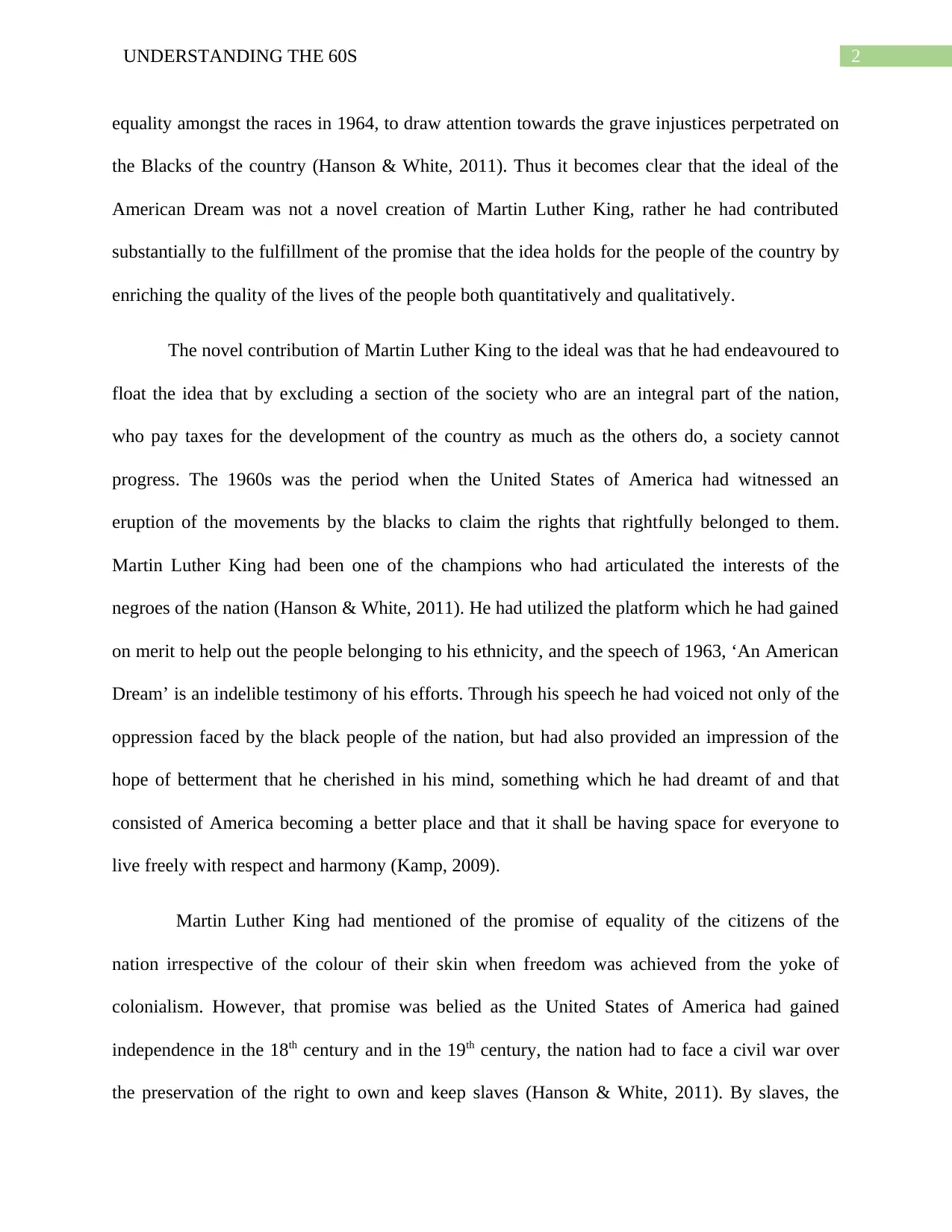
2UNDERSTANDING THE 60S
equality amongst the races in 1964, to draw attention towards the grave injustices perpetrated on
the Blacks of the country (Hanson & White, 2011). Thus it becomes clear that the ideal of the
American Dream was not a novel creation of Martin Luther King, rather he had contributed
substantially to the fulfillment of the promise that the idea holds for the people of the country by
enriching the quality of the lives of the people both quantitatively and qualitatively.
The novel contribution of Martin Luther King to the ideal was that he had endeavoured to
float the idea that by excluding a section of the society who are an integral part of the nation,
who pay taxes for the development of the country as much as the others do, a society cannot
progress. The 1960s was the period when the United States of America had witnessed an
eruption of the movements by the blacks to claim the rights that rightfully belonged to them.
Martin Luther King had been one of the champions who had articulated the interests of the
negroes of the nation (Hanson & White, 2011). He had utilized the platform which he had gained
on merit to help out the people belonging to his ethnicity, and the speech of 1963, ‘An American
Dream’ is an indelible testimony of his efforts. Through his speech he had voiced not only of the
oppression faced by the black people of the nation, but had also provided an impression of the
hope of betterment that he cherished in his mind, something which he had dreamt of and that
consisted of America becoming a better place and that it shall be having space for everyone to
live freely with respect and harmony (Kamp, 2009).
Martin Luther King had mentioned of the promise of equality of the citizens of the
nation irrespective of the colour of their skin when freedom was achieved from the yoke of
colonialism. However, that promise was belied as the United States of America had gained
independence in the 18th century and in the 19th century, the nation had to face a civil war over
the preservation of the right to own and keep slaves (Hanson & White, 2011). By slaves, the
equality amongst the races in 1964, to draw attention towards the grave injustices perpetrated on
the Blacks of the country (Hanson & White, 2011). Thus it becomes clear that the ideal of the
American Dream was not a novel creation of Martin Luther King, rather he had contributed
substantially to the fulfillment of the promise that the idea holds for the people of the country by
enriching the quality of the lives of the people both quantitatively and qualitatively.
The novel contribution of Martin Luther King to the ideal was that he had endeavoured to
float the idea that by excluding a section of the society who are an integral part of the nation,
who pay taxes for the development of the country as much as the others do, a society cannot
progress. The 1960s was the period when the United States of America had witnessed an
eruption of the movements by the blacks to claim the rights that rightfully belonged to them.
Martin Luther King had been one of the champions who had articulated the interests of the
negroes of the nation (Hanson & White, 2011). He had utilized the platform which he had gained
on merit to help out the people belonging to his ethnicity, and the speech of 1963, ‘An American
Dream’ is an indelible testimony of his efforts. Through his speech he had voiced not only of the
oppression faced by the black people of the nation, but had also provided an impression of the
hope of betterment that he cherished in his mind, something which he had dreamt of and that
consisted of America becoming a better place and that it shall be having space for everyone to
live freely with respect and harmony (Kamp, 2009).
Martin Luther King had mentioned of the promise of equality of the citizens of the
nation irrespective of the colour of their skin when freedom was achieved from the yoke of
colonialism. However, that promise was belied as the United States of America had gained
independence in the 18th century and in the 19th century, the nation had to face a civil war over
the preservation of the right to own and keep slaves (Hanson & White, 2011). By slaves, the
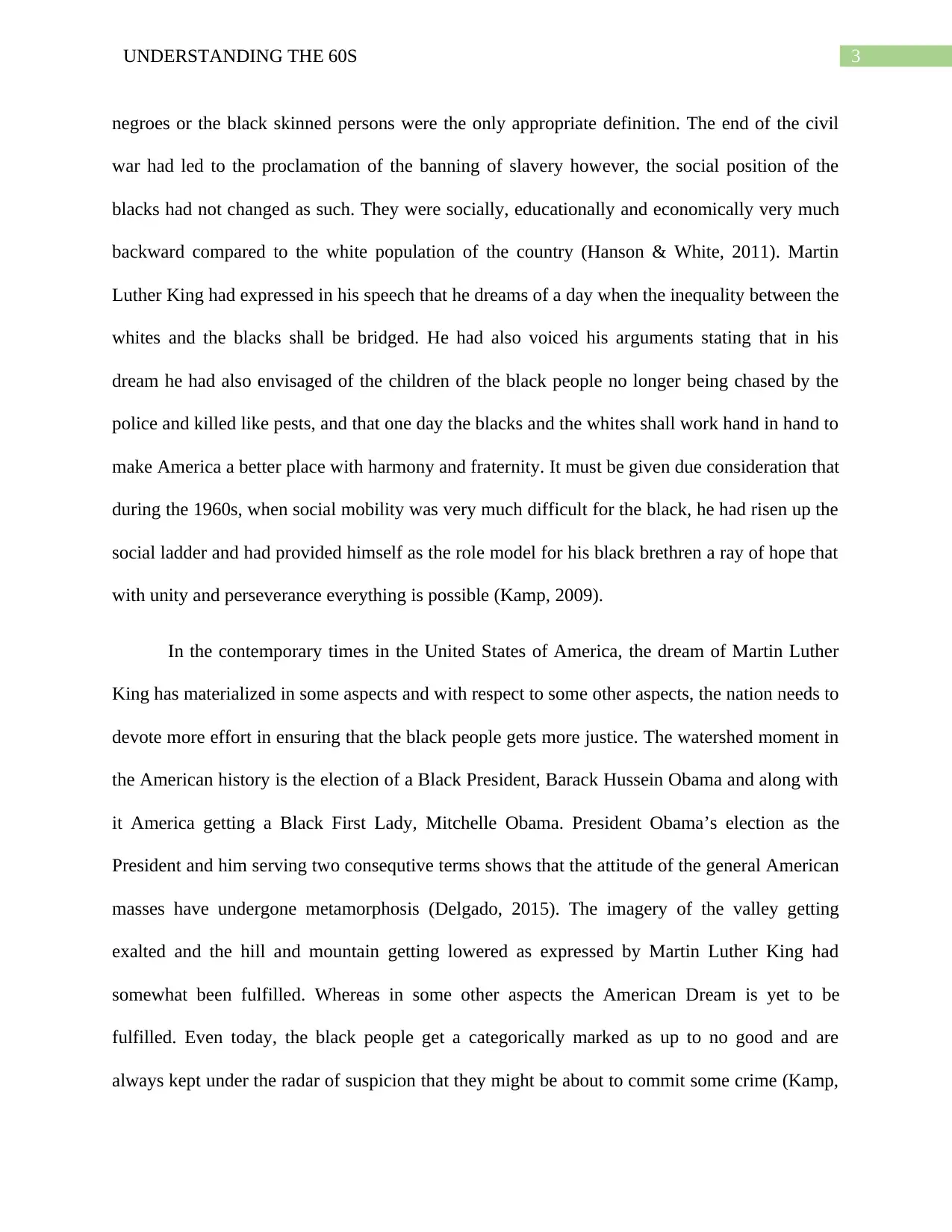
3UNDERSTANDING THE 60S
negroes or the black skinned persons were the only appropriate definition. The end of the civil
war had led to the proclamation of the banning of slavery however, the social position of the
blacks had not changed as such. They were socially, educationally and economically very much
backward compared to the white population of the country (Hanson & White, 2011). Martin
Luther King had expressed in his speech that he dreams of a day when the inequality between the
whites and the blacks shall be bridged. He had also voiced his arguments stating that in his
dream he had also envisaged of the children of the black people no longer being chased by the
police and killed like pests, and that one day the blacks and the whites shall work hand in hand to
make America a better place with harmony and fraternity. It must be given due consideration that
during the 1960s, when social mobility was very much difficult for the black, he had risen up the
social ladder and had provided himself as the role model for his black brethren a ray of hope that
with unity and perseverance everything is possible (Kamp, 2009).
In the contemporary times in the United States of America, the dream of Martin Luther
King has materialized in some aspects and with respect to some other aspects, the nation needs to
devote more effort in ensuring that the black people gets more justice. The watershed moment in
the American history is the election of a Black President, Barack Hussein Obama and along with
it America getting a Black First Lady, Mitchelle Obama. President Obama’s election as the
President and him serving two consequtive terms shows that the attitude of the general American
masses have undergone metamorphosis (Delgado, 2015). The imagery of the valley getting
exalted and the hill and mountain getting lowered as expressed by Martin Luther King had
somewhat been fulfilled. Whereas in some other aspects the American Dream is yet to be
fulfilled. Even today, the black people get a categorically marked as up to no good and are
always kept under the radar of suspicion that they might be about to commit some crime (Kamp,
negroes or the black skinned persons were the only appropriate definition. The end of the civil
war had led to the proclamation of the banning of slavery however, the social position of the
blacks had not changed as such. They were socially, educationally and economically very much
backward compared to the white population of the country (Hanson & White, 2011). Martin
Luther King had expressed in his speech that he dreams of a day when the inequality between the
whites and the blacks shall be bridged. He had also voiced his arguments stating that in his
dream he had also envisaged of the children of the black people no longer being chased by the
police and killed like pests, and that one day the blacks and the whites shall work hand in hand to
make America a better place with harmony and fraternity. It must be given due consideration that
during the 1960s, when social mobility was very much difficult for the black, he had risen up the
social ladder and had provided himself as the role model for his black brethren a ray of hope that
with unity and perseverance everything is possible (Kamp, 2009).
In the contemporary times in the United States of America, the dream of Martin Luther
King has materialized in some aspects and with respect to some other aspects, the nation needs to
devote more effort in ensuring that the black people gets more justice. The watershed moment in
the American history is the election of a Black President, Barack Hussein Obama and along with
it America getting a Black First Lady, Mitchelle Obama. President Obama’s election as the
President and him serving two consequtive terms shows that the attitude of the general American
masses have undergone metamorphosis (Delgado, 2015). The imagery of the valley getting
exalted and the hill and mountain getting lowered as expressed by Martin Luther King had
somewhat been fulfilled. Whereas in some other aspects the American Dream is yet to be
fulfilled. Even today, the black people get a categorically marked as up to no good and are
always kept under the radar of suspicion that they might be about to commit some crime (Kamp,
Secure Best Marks with AI Grader
Need help grading? Try our AI Grader for instant feedback on your assignments.
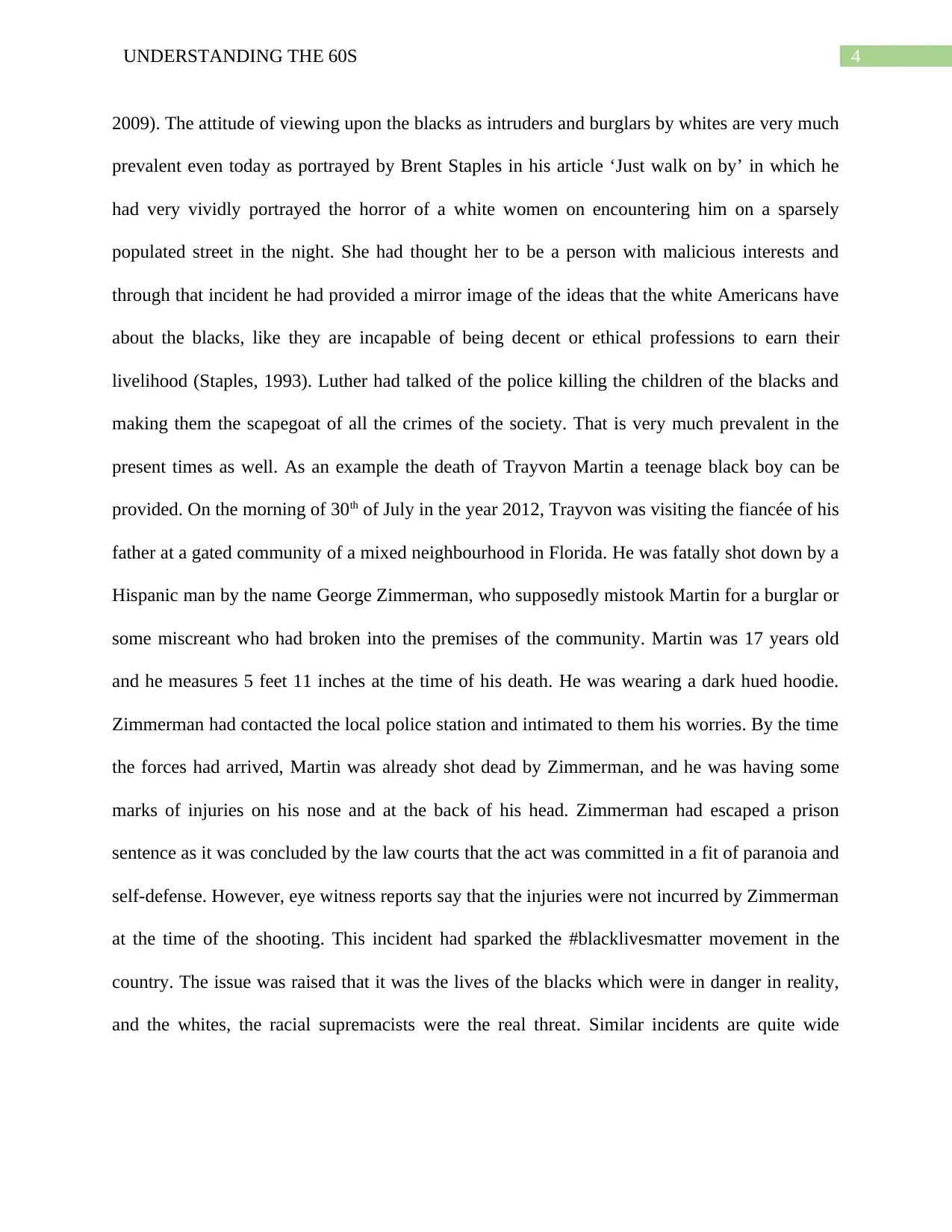
4UNDERSTANDING THE 60S
2009). The attitude of viewing upon the blacks as intruders and burglars by whites are very much
prevalent even today as portrayed by Brent Staples in his article ‘Just walk on by’ in which he
had very vividly portrayed the horror of a white women on encountering him on a sparsely
populated street in the night. She had thought her to be a person with malicious interests and
through that incident he had provided a mirror image of the ideas that the white Americans have
about the blacks, like they are incapable of being decent or ethical professions to earn their
livelihood (Staples, 1993). Luther had talked of the police killing the children of the blacks and
making them the scapegoat of all the crimes of the society. That is very much prevalent in the
present times as well. As an example the death of Trayvon Martin a teenage black boy can be
provided. On the morning of 30th of July in the year 2012, Trayvon was visiting the fiancée of his
father at a gated community of a mixed neighbourhood in Florida. He was fatally shot down by a
Hispanic man by the name George Zimmerman, who supposedly mistook Martin for a burglar or
some miscreant who had broken into the premises of the community. Martin was 17 years old
and he measures 5 feet 11 inches at the time of his death. He was wearing a dark hued hoodie.
Zimmerman had contacted the local police station and intimated to them his worries. By the time
the forces had arrived, Martin was already shot dead by Zimmerman, and he was having some
marks of injuries on his nose and at the back of his head. Zimmerman had escaped a prison
sentence as it was concluded by the law courts that the act was committed in a fit of paranoia and
self-defense. However, eye witness reports say that the injuries were not incurred by Zimmerman
at the time of the shooting. This incident had sparked the #blacklivesmatter movement in the
country. The issue was raised that it was the lives of the blacks which were in danger in reality,
and the whites, the racial supremacists were the real threat. Similar incidents are quite wide
2009). The attitude of viewing upon the blacks as intruders and burglars by whites are very much
prevalent even today as portrayed by Brent Staples in his article ‘Just walk on by’ in which he
had very vividly portrayed the horror of a white women on encountering him on a sparsely
populated street in the night. She had thought her to be a person with malicious interests and
through that incident he had provided a mirror image of the ideas that the white Americans have
about the blacks, like they are incapable of being decent or ethical professions to earn their
livelihood (Staples, 1993). Luther had talked of the police killing the children of the blacks and
making them the scapegoat of all the crimes of the society. That is very much prevalent in the
present times as well. As an example the death of Trayvon Martin a teenage black boy can be
provided. On the morning of 30th of July in the year 2012, Trayvon was visiting the fiancée of his
father at a gated community of a mixed neighbourhood in Florida. He was fatally shot down by a
Hispanic man by the name George Zimmerman, who supposedly mistook Martin for a burglar or
some miscreant who had broken into the premises of the community. Martin was 17 years old
and he measures 5 feet 11 inches at the time of his death. He was wearing a dark hued hoodie.
Zimmerman had contacted the local police station and intimated to them his worries. By the time
the forces had arrived, Martin was already shot dead by Zimmerman, and he was having some
marks of injuries on his nose and at the back of his head. Zimmerman had escaped a prison
sentence as it was concluded by the law courts that the act was committed in a fit of paranoia and
self-defense. However, eye witness reports say that the injuries were not incurred by Zimmerman
at the time of the shooting. This incident had sparked the #blacklivesmatter movement in the
country. The issue was raised that it was the lives of the blacks which were in danger in reality,
and the whites, the racial supremacists were the real threat. Similar incidents are quite wide
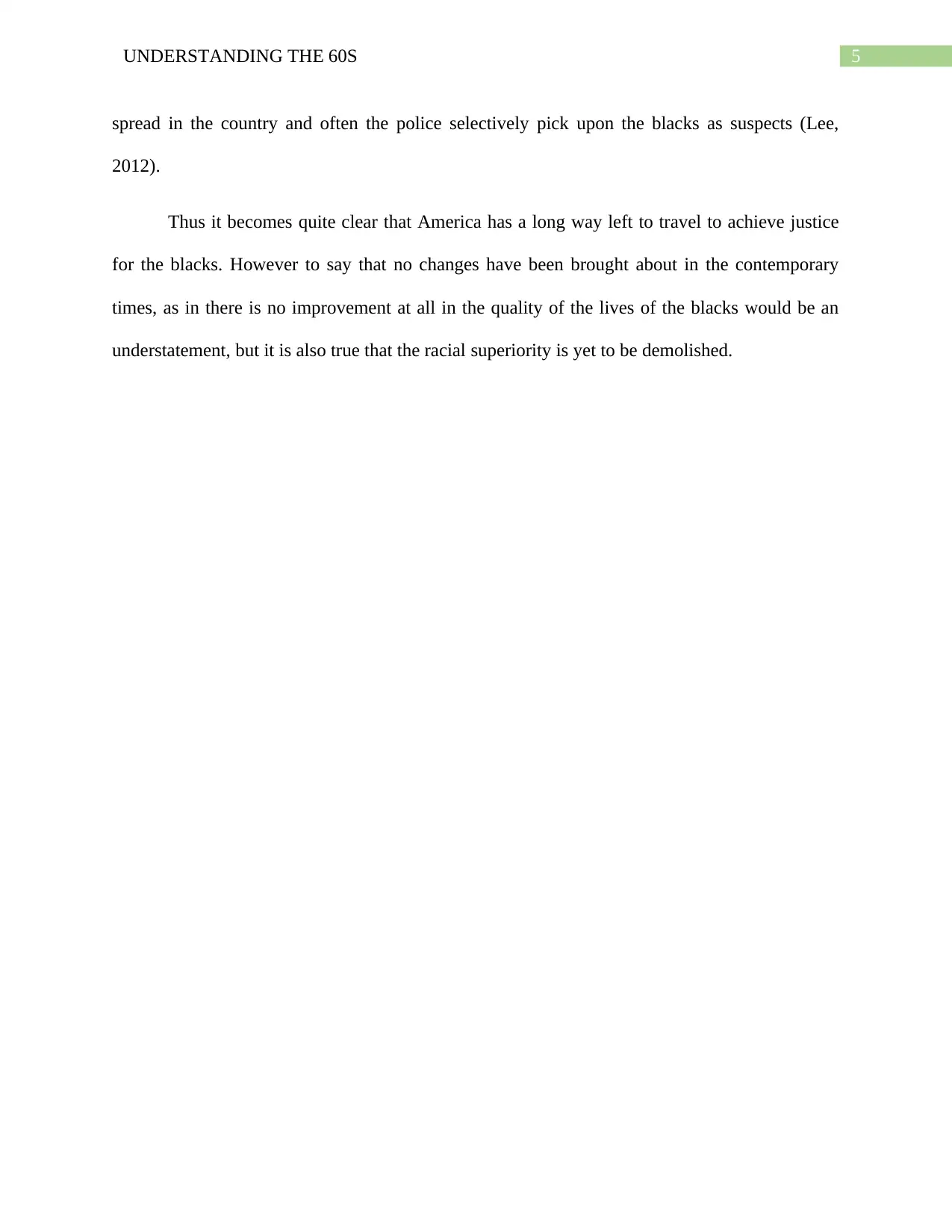
5UNDERSTANDING THE 60S
spread in the country and often the police selectively pick upon the blacks as suspects (Lee,
2012).
Thus it becomes quite clear that America has a long way left to travel to achieve justice
for the blacks. However to say that no changes have been brought about in the contemporary
times, as in there is no improvement at all in the quality of the lives of the blacks would be an
understatement, but it is also true that the racial superiority is yet to be demolished.
spread in the country and often the police selectively pick upon the blacks as suspects (Lee,
2012).
Thus it becomes quite clear that America has a long way left to travel to achieve justice
for the blacks. However to say that no changes have been brought about in the contemporary
times, as in there is no improvement at all in the quality of the lives of the blacks would be an
understatement, but it is also true that the racial superiority is yet to be demolished.
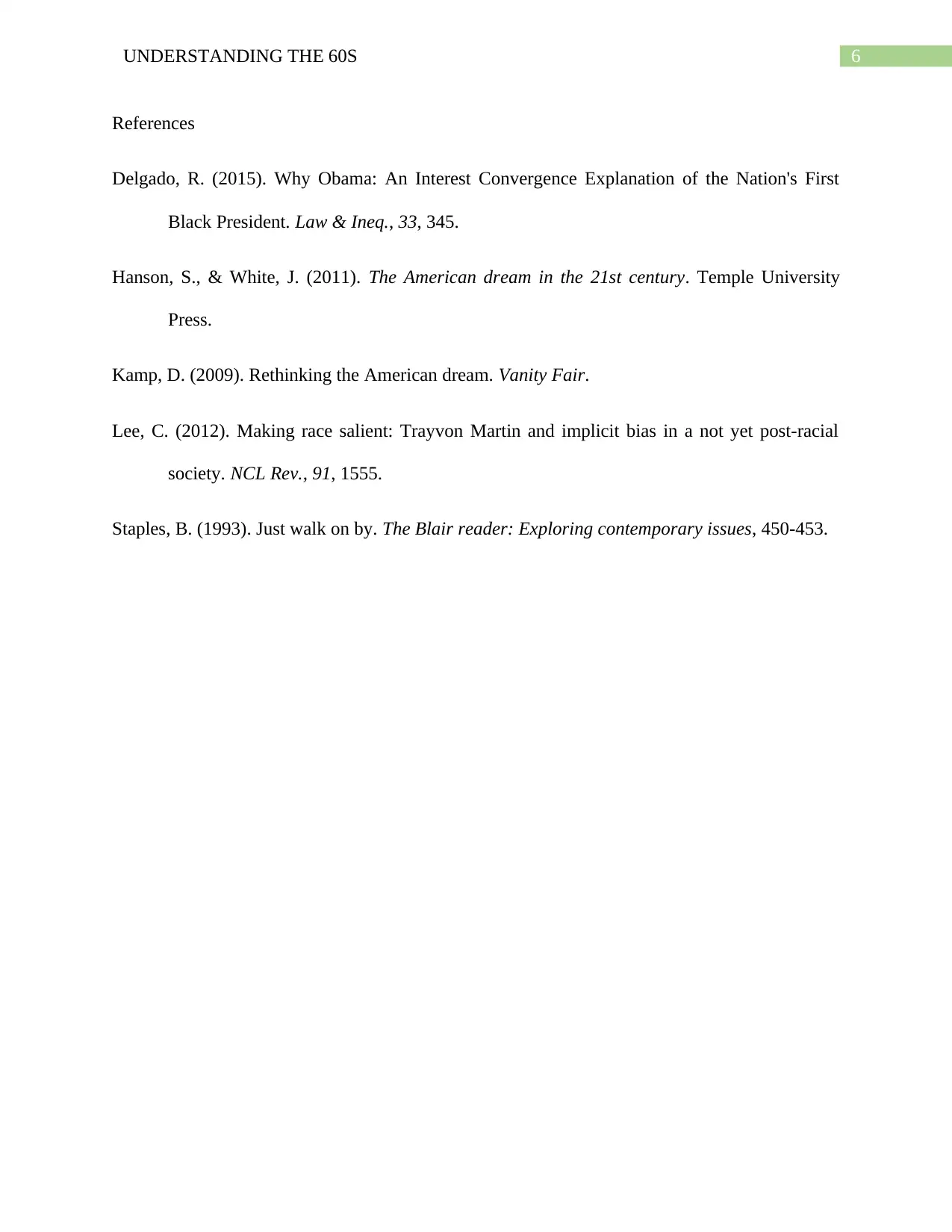
6UNDERSTANDING THE 60S
References
Delgado, R. (2015). Why Obama: An Interest Convergence Explanation of the Nation's First
Black President. Law & Ineq., 33, 345.
Hanson, S., & White, J. (2011). The American dream in the 21st century. Temple University
Press.
Kamp, D. (2009). Rethinking the American dream. Vanity Fair.
Lee, C. (2012). Making race salient: Trayvon Martin and implicit bias in a not yet post-racial
society. NCL Rev., 91, 1555.
Staples, B. (1993). Just walk on by. The Blair reader: Exploring contemporary issues, 450-453.
References
Delgado, R. (2015). Why Obama: An Interest Convergence Explanation of the Nation's First
Black President. Law & Ineq., 33, 345.
Hanson, S., & White, J. (2011). The American dream in the 21st century. Temple University
Press.
Kamp, D. (2009). Rethinking the American dream. Vanity Fair.
Lee, C. (2012). Making race salient: Trayvon Martin and implicit bias in a not yet post-racial
society. NCL Rev., 91, 1555.
Staples, B. (1993). Just walk on by. The Blair reader: Exploring contemporary issues, 450-453.
1 out of 7
Related Documents
Your All-in-One AI-Powered Toolkit for Academic Success.
+13062052269
info@desklib.com
Available 24*7 on WhatsApp / Email
![[object Object]](/_next/static/media/star-bottom.7253800d.svg)
Unlock your academic potential
© 2024 | Zucol Services PVT LTD | All rights reserved.
